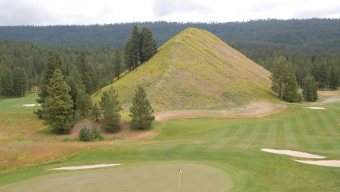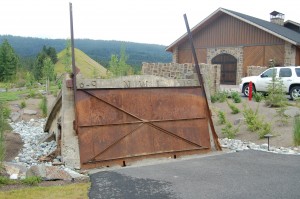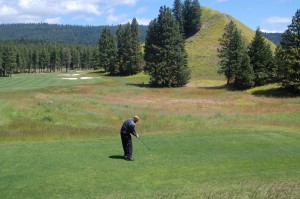(Editor’s Note: This story on the new Rope Rider course originally appeared in the August 2011 edition of Pacific Northwest Golfer. This is the first full summer for the Jacobsen-Hardy designed Rope Rider as it has joined Prospector and Tumble Creek at the Suncadia Resort in the Cascades, a couple hours east of Seattle)
By Bob Sherwin
ROSLYN, Wa. – Suncadia Resort’s new Rope Rider golf course can be celebrated for its embrace of incongruity.
Rope Rider, the final piece of Suncadia’s 54-hole golf course complex, is a disparate mix of elements. It’s mine shafts and signature holes, wine tasting and ball striking, corporate banquets and family pizza parties.
They co-exist together in this rolling, forested terrain amid the breath-taking Cascade Mountains. The 7,203-yard layout joins Prospector, which opened in 2010, and the private 6-year-old Tumble Creek golf course all under the Suncadia umbrella.
It took six years and couple design firms to finish Rope Rider, the first new golf course to begin operations in the state since Chambers Bay near Tacoma in 2007.
Throughout the process, the developers – from Jacobsen Hardy Golf Course Design – were careful to respect the natural elements as well as the history and heritage of the rugged coal miners who worked the craggy mines below the now lush fairways.
The name Rope Rider stems from the roped coal cars that perilously negotiated the steep and deep mine shafts to extract the ore. Railroad cars took the coal directly from the site through Stampede Pass to Chicago, helping to power the major Midwest cities for most of the 20th Century. The mines operated from the 1890s to 1963 when the last shaft was closed and sealed.
Sitting in the middle of the course is the most visible trace of the coal mine operations – the 120-foot Tipple Hill, consisting of tailings or waste material from the mining process.
The legacy of those miners has been honored with 18 new shafts, each four inches deep, 4 1/2-inches wide.
“I think it’s the perfect resort golf. I’m very much in love with that course,” said Jared Jeffries, Suncadia’s club manager. “You can take it to the back tees and host any Northwest tournament and really show it off. But for daily play, it will bring people in because it’s good construction, it’s built right.”
Just a short wedge from Tipple Hill is the 41,000-square foot, $10 million Swiftwater Cellars, the spectacular anchor of the Rope Rider property. The course’s pro shop and cart storage are enveloped into the massive winery in a symbiotic blend of wines, mines and nines.
“When people come here and see Tipple for the first time they say, ‘what is that?’ It gives our staff a great opportunity to lead them into the history from late 1890s to now of the coal mining business in the Roslyn/Cle Elum area,” said Don Watts, a longtime Central Washington farmer and vintner who opened the winery/restaurant in the fall of 2010.
“I think history in general of Roslyn is great gift, as a talking point, a great history. It’s very interesting,” Watts added. “It’s amazing how many people in the state of Washington who spent all their lives here know nothing about it.”
Jeffries said that, “wine, golf and families, those three things don’t necessarily go together, but Don embraced the family element here. He put in a wood-fired pizza oven. We’ll have a children’s menu. It’s not just a place where you and your wife go. You can take your kids, your grandkids, be able to have lunch or a wine-tasting. It melds it all together very well, an experience for everybody, not just adults.”
What it also melds, strangely yet naturally, is the golf experience with the coal mining past. The slanted No. 9 and No. 10 mine shafts, poking up several yards out of the ground, bookend the Swiftwater structure. It wasn’t planned this way but shaft No. 9 just happens to run under the ninth hole and shaft No. 10 extends under the 10th hole.
That Tipple Hill waste pile is the course’s featured element, purposely untouched by the designers. Holes No. 7, 8 and 9 encircle it.
Jacobsen, the PGA golfer and TV analysis, and partner Jim Hardy, “believed Tipple was an asset to the property and the course. We wanted to work off of it,” said Rex VanHoose, the firm’s design partner.
What the designers wanted was a course that could delight the resort’s corporate clients but also was family adaptable. They wanted a course that challenged the good players at its edges but not so hard that the young, inexperienced or average golfers would become disheartened. There are four tee boxes, plus one for junior players 80 to 160 yards from the greens.
“You have to give credit to them (Suncadia folks). They wanted a fun, friendly course that can be intriguing to people of all different skill levels, seniors, women, juniors,” said VanHoose.
The Jacobsen-Hardy style is playability. They want golfers from the various tee positions to be rewarded for decent shots and not be so severely penalized for errant ones. There are no forced carries. Fairways are wide. Bunkers are strategically placed, generally to the left or right of greens, never directly in front. By design, shots can bounce onto greens on every hole.
“They painted a vision of our lifestyle,” Jeffries said.
The first hole is an example of the Jacobsen-Hardy approach. It’s a gentle dogleg right, 548-yard (499 yards from the blue tees) par-5. Large bunkers along the right side can snatch drives but there’s acres of room on the left to avoid them. Then on the second shot, the golfer needs to steer away from water guarding the left side. It’s a reachable green with a precise shot, offering hope for a fast start.
Jacobsen-Hardy also looks for ways to balance the course with sub-par and plus-par holes. In other words, there may be some par-4s a bit shorter, allowing the golfer to have a shot at birdie. And some you may have to give back a stroke or two.
The third hole is 342 yards – just 272 from the blue tees – is the best example. If the golfer can reach a rise just beyond 200 yards out, on some days the the ball may roll down a slope close to or onto the green.
Putting for eagle!
“No. 3 is a drivable par-4,” VanHoose said. “Peter and Jim love to introduce that style. It injects a lot of fun into the game. People look forward to that.”
No. 15, a par-4, 388-yarder (338 yards from the blues) with the prevailing wind generally behind the tee, also can build birdie fever.
However, the course mixes in the longer, difficult, eight-bunker par-5, 580 yard (515 yards from the blues) 17th hole. It should be more reasonably designated as a par-6, especially with the wind more often than not in the golfer’s face.
At the end, the par-4, 401-yard (340 yards from the blues) 18th one day may be considered among the best finishing holes in the state. It doglegs slightly right over a wide body of water. Long drivers boldly can steer a shot over the water to the green, but it’s not without considerable risk. How close you want to be to the green depends solely on how much you want to bite off of the water.
Your approach shot also may be a precarious venture as the wide but narrow green is protected by a deep bunker on the far right – where the pin likely will perch behind – and the feathery fescue to the left.
Built into the course is another unique element – loops. There’s a six-hole loop, No. 1 through No. 6, that begins and ends close to the Swiftwater clubhouse. There’s a three-hole loop, No. 7 through No. 9 – the Tipple Loop – also is adjacent and accessible from Swiftwater.
“We thought we’d be able to create a different type of golf course,” VanHoose said. “It gives flexibility from the resort standpoint.”
The loops allow the course to serve golfers with time restraints.
“They may have a time commitment or they just want to play less golf, so we built in the loop system,” Jeffries said. “Maybe they just want to have an outing with the family for one or two hours then enjoy the winery.”
He added that the Jacobsen-Hardy design philosophy matched what the Suncadia people wanted to create.
“It all fits pretty well,” Jeffries added.























